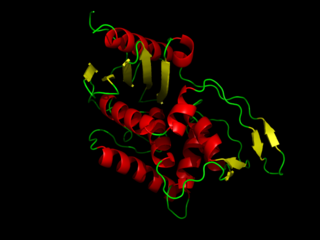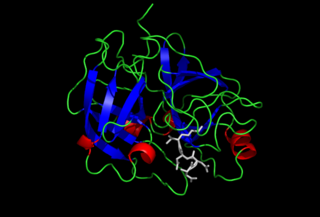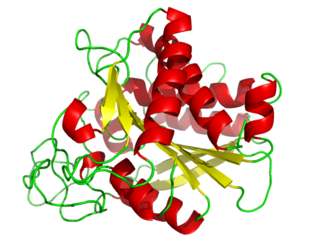Related Research Articles

DD-transpeptidase is a bacterial enzyme that catalyzes the transfer of the R-L-αα-D-alanyl moiety of R-L-αα-D-alanyl-D-alanine carbonyl donors to the γ-OH of their active-site serine and from this to a final acceptor. It is involved in bacterial cell wall biosynthesis, namely, the transpeptidation that crosslinks the peptide side chains of peptidoglycan strands.

Enteropeptidase is an enzyme produced by cells of the duodenum and is involved in digestion in humans and other animals. Enteropeptidase converts trypsinogen into its active form trypsin, resulting in the subsequent activation of pancreatic digestive enzymes. Absence of enteropeptidase results in intestinal digestion impairment.

Furin is a protease, a proteolytic enzyme that in humans and other animals is encoded by the FURIN gene. Some proteins are inactive when they are first synthesized, and must have sections removed in order to become active. Furin cleaves these sections and activates the proteins. It was named furin because it was in the upstream region of an oncogene known as FES. The gene was known as FUR and therefore the protein was named furin. Furin is also known as PACE. A member of family S8, furin is a subtilisin-like peptidase.

A carboxypeptidase is a protease enzyme that hydrolyzes (cleaves) a peptide bond at the carboxy-terminal (C-terminal) end of a protein or peptide. This is in contrast to an aminopeptidases, which cleave peptide bonds at the N-terminus of proteins. Humans, animals, bacteria and plants contain several types of carboxypeptidases that have diverse functions ranging from catabolism to protein maturation. At least two mechanisms have been discussed.

A disintegrin and metalloprotease 17 (ADAM17), also called TACE, is a 70-kDa enzyme that belongs to the ADAM protein family of disintegrins and metalloproteases.

Carboxypeptidase E (CPE), also known as carboxypeptidase H (CPH) and enkephalin convertase, is an enzyme that in humans is encoded by the CPE gene. This enzyme catalyzes the release of C-terminal arginine or lysine residues from polypeptides.

Procollagen-proline dioxygenase, commonly known as prolyl hydroxylase, is a member of the class of enzymes known as alpha-ketoglutarate-dependent hydroxylases. These enzymes catalyze the incorporation of oxygen into organic substrates through a mechanism that requires alpha-Ketoglutaric acid, Fe2+, and ascorbate. This particular enzyme catalyzes the formation of (2S, 4R)-4-hydroxyproline, a compound that represents the most prevalent post-translational modification in the human proteome.

In enzymology, a microsomal epoxide hydrolase (mEH) is an enzyme that catalyzes the hydrolysis reaction between an epoxide and water to form a diol.

A Disintegrin and metalloproteinase domain-containing protein 10, also known as ADAM10 or CDw156 or CD156c is a protein that in humans is encoded by the ADAM10 gene.

Retinal pigment epithelium-specific 65 kDa protein, also known as retinoid isomerohydrolase, is an enzyme of the vertebrate visual cycle that is encoded in humans by the RPE65 gene. RPE65 is expressed in the retinal pigment epithelium and is responsible for the conversion of all-trans-retinyl esters to 11-cis-retinol during phototransduction. 11-cis-retinol is then used in visual pigment regeneration in photoreceptor cells. RPE65 belongs to the carotenoid oxygenase family of enzymes.

Dipeptidase 1 (DPEP1), or renal dipeptidase, is a membrane-bound glycoprotein responsible for hydrolyzing dipeptides. It is found in the microsomal fraction of the porcine kidney cortex. It exists as a disulfide-linked homodimer that is glygosylphosphatidylinositol (GPI)-anchored to the renal brush border of the kidney. The active site on each homodimer is made up of a barrel subunit with binuclear zinc ions that are bridged by the Gly125 side-chain located at the bottom of the barrel.

Carboxypeptidase D is an enzyme that in humans is encoded by the CPD gene.

Xaa-Pro aminopeptidase 1 is an enzyme that in humans is encoded by the XPNPEP1 gene.

Xaa-Pro aminopeptidase 2 is an enzyme that in humans is encoded by the XPNPEP2 gene.
The Colworth Medal is awarded annually by the Biochemical Society to an outstanding research biochemist under the age of 35 and working mainly in the United Kingdom. The award is one of the most prestigious recognitions for young scientists in the UK, and was established by Tony James FRS at Unilever Research and Henry Arnstein of the Biochemical Society and takes its name from a Unilever research laboratory near Bedford in the UK, Colworth House.

Signal peptidases are enzymes that convert secretory and some membrane proteins to their mature or pro forms by cleaving their signal peptides from their N-termini.
Xaa-Pro aminopeptidase is an enzyme. This enzyme catalyses the following chemical reaction
Xaa-Trp aminopeptidase is an enzyme. This enzyme catalyses the following chemical reaction
Lysosomal Pro-Xaa carboxypeptidase is an enzyme. This enzyme catalyses the following chemical reaction
Peptidyl-Lys metalloendopeptidase is an enzyme. This enzyme catalyses the following chemical reaction
References
- ↑ Dehm P, Nordwig A (December 1970). "The cleavage of prolyl peptides by kidney peptidases. Isolation of a microsomal carboxypeptidase from swine kidney". European Journal of Biochemistry. 17 (2): 372–7. doi: 10.1111/j.1432-1033.1970.tb01175.x . PMID 5500406.
- ↑ Booth AG, Hubbard LM, Kenny AJ (May 1979). "Proteins of the kidney microvillar membrane. Immunoelectrophoretic analysis of the membrane hydrolases: identification and resolution of the detergent- and proteinase-solubilized forms". The Biochemical Journal. 179 (2): 397–405. doi:10.1042/bj1790397. PMC 1186637 . PMID 486090.
- ↑ Hedeager-Sørensen S, Kenny AJ (July 1985). "Proteins of the kidney microvillar membrane. Purification and properties of carboxypeptidase P from pig kidneys". The Biochemical Journal. 229 (1): 251–7. doi:10.1042/bj2290251. PMC 1145174 . PMID 4038259.